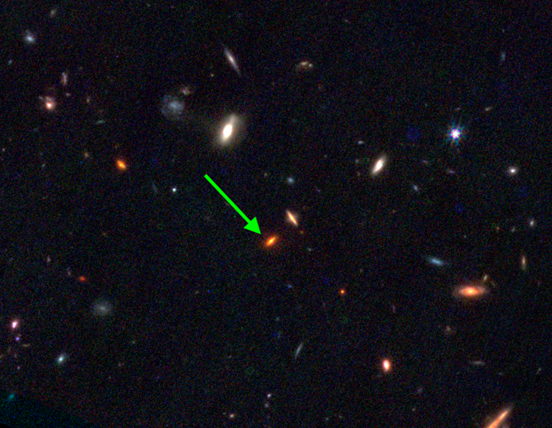‘Beyond what’s possible’: new JWST observations unearth mysterious ancient galaxies

JWST-7329: a rare massive galaxy that formed very early in the Universe. This JWST NIRCAM image shows a red disk galaxy but with images alone it is hard to distinguish from other objects. Spectral analysis of its light with JWST revealed its anomalous nature – it formed around 13 billions years ago even though it contains ~4x more mass in stars than our Milky Way does today.
In summary
- Our understanding of how galaxies form and the nature of dark matter could be completely upended
- A paper published in Nature details findings using new data from the James Webb Space Telescope
- Distinguished Professor Karl Glazebrook led the study and the international team
Our understanding of how galaxies form and the nature of dark matter could be completely upended, after new observations of a stellar population bigger than the Milky Way from more than 11 billion years ago that should not exist.
A paper published in Nature details findings using new data from the James Webb Space Telescope (JWST). The results finds that a massive galaxy in the early universe – observed 11.5 billion years ago (a cosmic redshift of 3.2) – has an extremely old population of stars formed much earlier – 1.5 billion years earlier in time (a red shift of around 11). The observation upends current modelling, as not enough dark matter has built up in sufficient concentrations to seed their formation.
Swinburne University of Technology’s Distinguished Professor Karl Glazebrook led the study and the international team who used the JWST for spectroscopic observations of this massive quiescent galaxy.
“We’ve been chasing this particular galaxy for seven years and spent hours observing it with the two largest telescopes on earth to figure out how old it was. But it was too red and too faint, and we couldn’t measure it. In the end, we had to go off earth and use the JWST to confirm its nature.”
The formation of galaxies is a fundamental paradigm underpinning modern astrophysics and predicts a strong decline in the number of massive galaxies in early cosmic times. Extremely massive quiescent galaxies have now been observed as early as one to two billion years after the Big Bang which challenges previous theoretical models.
Distinguished Professor Glazebrook worked with leading researchers all over the world, including Dr Themiya Nanayakkara, Dr Lalitwadee Kawinwanichakij, Dr Colin Jacobs, Dr Harry Chittenden, Associate Professor Glenn G Kacprzak and Associate Professor Ivo Labbe from Swinburne’s Centre for Astrophysics and Supercomputing.
“This was very much a team effort, from the infrared sky surveys we started in 2010 that led to us identifying this galaxy as unusual, to our many hours on the Keck and Very Large Telescope where we tried, but failed to confirm it, until finally the last year where we spent enormous effort figuring out how to process the JWST data and analyse this spectrum.”
Dr Themiya Nanayakkara, who led the spectral analysis of the JWST data, says, “we are now going beyond what was possible to confirm the oldest massive quiescent monsters that exist deep in the Universe.”
“This pushes the boundaries of our current understanding of how galaxies form and evolve. The key question now is how they form so fast very early in the Universe and what mysterious mechanisms leads to stopping them forming stars abruptly when the rest of the Universe doing so.”
Associate Professor Claudia Lagos from the University of Western Australia node of the International Centre for Radio Astronomy Research (ICRAR) was crucial in developing the theoretical modelling of the evolution of dark matter concentrations for the study.
“Galaxy formation is in large part dictated by how dark matter concentrates,” she says. “Having these extremely massive galaxies so early in the Universe is posing significant challenges to our standard model of cosmology. This is because we don't think such massive dark matter structures as to host these massive galaxies have had time yet to form. More observations are needed to understand how common these galaxies may be and to help us understand how truly massive these galaxies are."
Distinguished Professor Glazebrook hopes this could be a new opening for our understanding of the physics of dark matter.
“JWST has been finding increasing evidence for massive galaxies forming early in time. This result sets a new record for this phenomenon. Although it is very striking, it is only one object. But we hope to find more; and if we do this will really upset our ideas of galaxy formation.”
-
Media Enquiries
Related articles
-

- Astronomy
High school students work with Swinburne astronomers on the future of space
Swinburne’s Youth Space Innovation Challenge has inspired over 330 Australian teenagers to pursue a career in STEM.
Friday 26 July 2024 -

- Astronomy
- Science
Swinburne appoints new Director of Innovative Planet Research Institute
Leading geodesy expert, Professor Allison Kealy, has been appointed as the inaugural Director of Swinburne University's Innovative Planet Research Institute.
Monday 22 April 2024 -

- Astronomy
- University
OzGrav 2.0: A ‘new era of astrophysics’ launched at Swinburne
The next phase in the world-leading ARC Centre of Excellence for Gravitational Wave Discovery, dubbed 'OzGrav 2.0', launched this week at Swinburne University of Technology.
Wednesday 17 April 2024 -

- Design
- Astronomy
- Technology
- University
Swinburne ‘Rock Muncher’ takes part in Australian Rover Challenge
A multidisciplinary student team from Swinburne University of Technology competed in the 2024 Australian Rover Challenge held in Adelaide, South Australia.
Thursday 11 April 2024 -
.jpeg/_jcr_content/renditions/cq5dam.web.256.144.jpeg)
- Astronomy
New JWST observations reveal black holes rapidly shut off star formation in massive galaxies
New research showcases new observations from the James Webb Space Telescope that suggest black holes rapidly shut off star-formation in massive galaxies by explosively removing large amounts of gas...
Tuesday 23 April 2024

